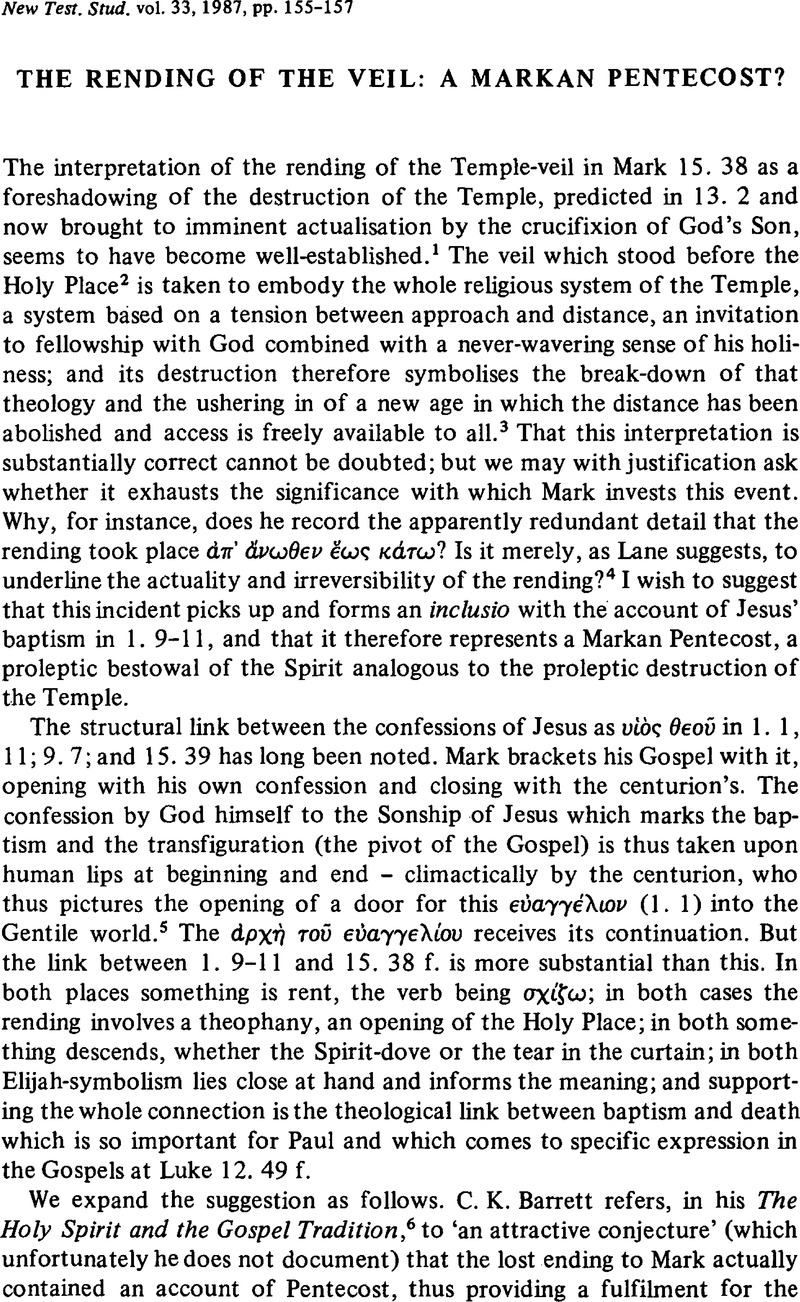Article contents
The Rending of the Veil: A Markan Pentecost?
Published online by Cambridge University Press: 05 February 2009
Abstract

Information
- Type
- Short Studies
- Information
- Copyright
- Copyright © Cambridge University Press 1987
References
Notes
[1] Amongst older commentators, we may mention Rawlinson, A. E. J., St. Mark (Methuen; London, 1925) 238Google Scholar; more recently, we may mention Anderson, H., The Gospel of Mark (Oliphants; London, 1976) 347Google Scholar; Johnson, S. E., The Gospel According to St Mark (A. & C. Black; London, 1972) 257Google Scholar; Schweizer, E., Das Evangelinm nach Markus (Evangelische Verlagsanstalt; Berlin, 1981) 195.Google Scholar
[2] It is hard to know whether Mark is referring to the curtain before the Holy Place, which would have been visible to all who approached or entered the Court of the Priests, or to that separating the Holy Place from the Holy of Holies, which would only have been visible to the priests on duty. The latter would have been a more powerful theological symbol for Mark, but the tradition that visible and obvious signs accompanied and explained the death of Jesus is well-established in the Gospels (cf. Matt 27. 45, 51 ff.), and I therefore incline to the opinion of Lane, W. L. (The Gospel According to Mark [Eerdmans; Grand Rapids, 1974] 574 f.)Google Scholar that the outer curtain is intended.
[3] It seems strange that several commentators feel compelled to choose between rival expla nations of the rending – either signifying the destruction of the Temple, or pointing to new access to God: so, e.g. Nineham, D. E., Saint Mark (Penguin; London, 1963) 430.Google Scholar The two interpretations are complementary. The rending of the veil is the climax of a concern with the Temple which begins with Jesus' entry into Jerusalem in ch. 11: there, the meaning of the Cleansing of the Temple is not only clarified by the cursing of the fig tree (which reveals it to be an act of judgement heralding destruction), but also by the following discourse on the nature of true prayer (11. 22–25): having cleansed the Temple because it is no longer a ‘house of prayer’ (11. 17), Jesus now teaches that true prayer is defined not by its location but by its spirit (one of faith, vv. 22–24, and of forgive ness, v. 25). The cleansing of the Temple thus has the same two complementary meanings as the rending of the veth on the one hand negative, pointing to the removal of the old system of worship, and on the other positive, indicating the establishing of a new system.
[4] Lane,575.
[5] So Schweizer, 197; Lightfoot, R. H., The Gospel Message of St. Mark (O.U.P.; Oxford, 1950) 57.Google Scholar
[6] S.P.C.K. (London, 1947) 125.
[7] The Message of Mark (Epworth; London, 1983) 10.Google Scholar
[8] So, for instance, Lane, 55; Cranfield, C. E. B., The Gospel According to Mark (C.U.P.; Cambridge, 1959) 53CrossRefGoogle Scholar; Schweizer, 15.
[9] As noted, for instance, by Anderson, 346 and by Schweizer, 194, the misinterpretation of the cry from the cross probably rests upon the popular belief that Elijah, because he did not die in the normal way, was free to return to help the godly in times of special need. Because Jesus has been presented as an Elisha figure, there is perhaps some further irony in the fact that έγκαταλείω is notonly the word used in Ps 21. 2, but also that used in 4 Kings 2. 4, 6 by Elisha, in his protestation that he will not abandon Elijah.
- 3
- Cited by

